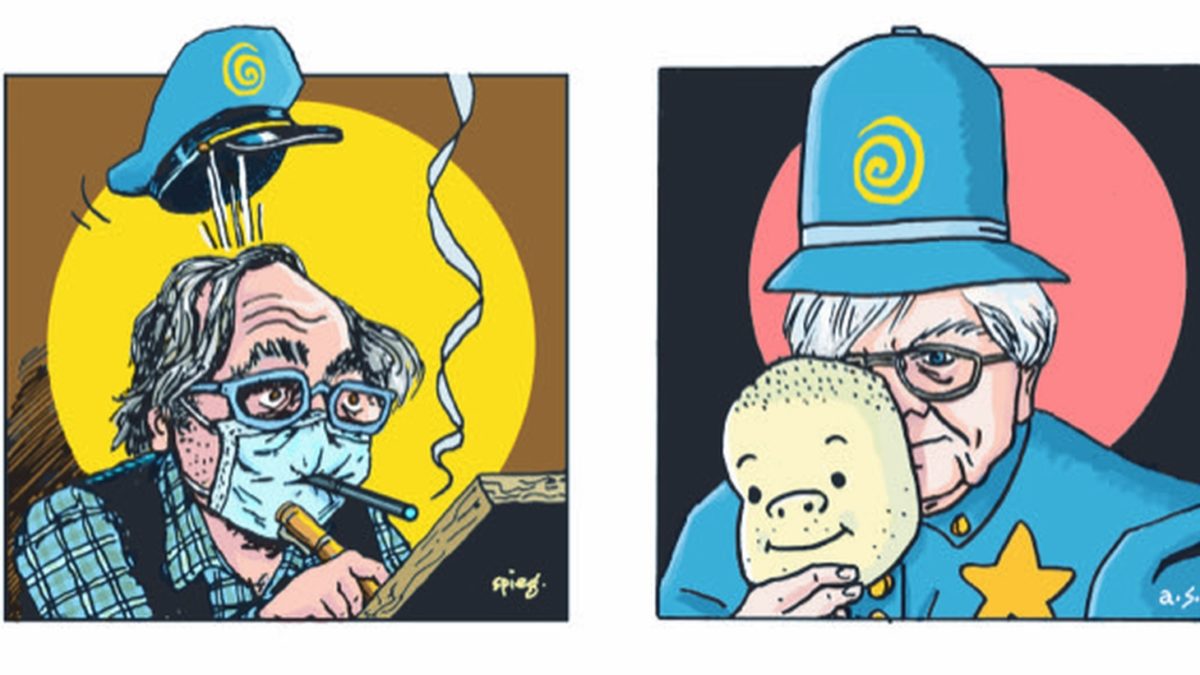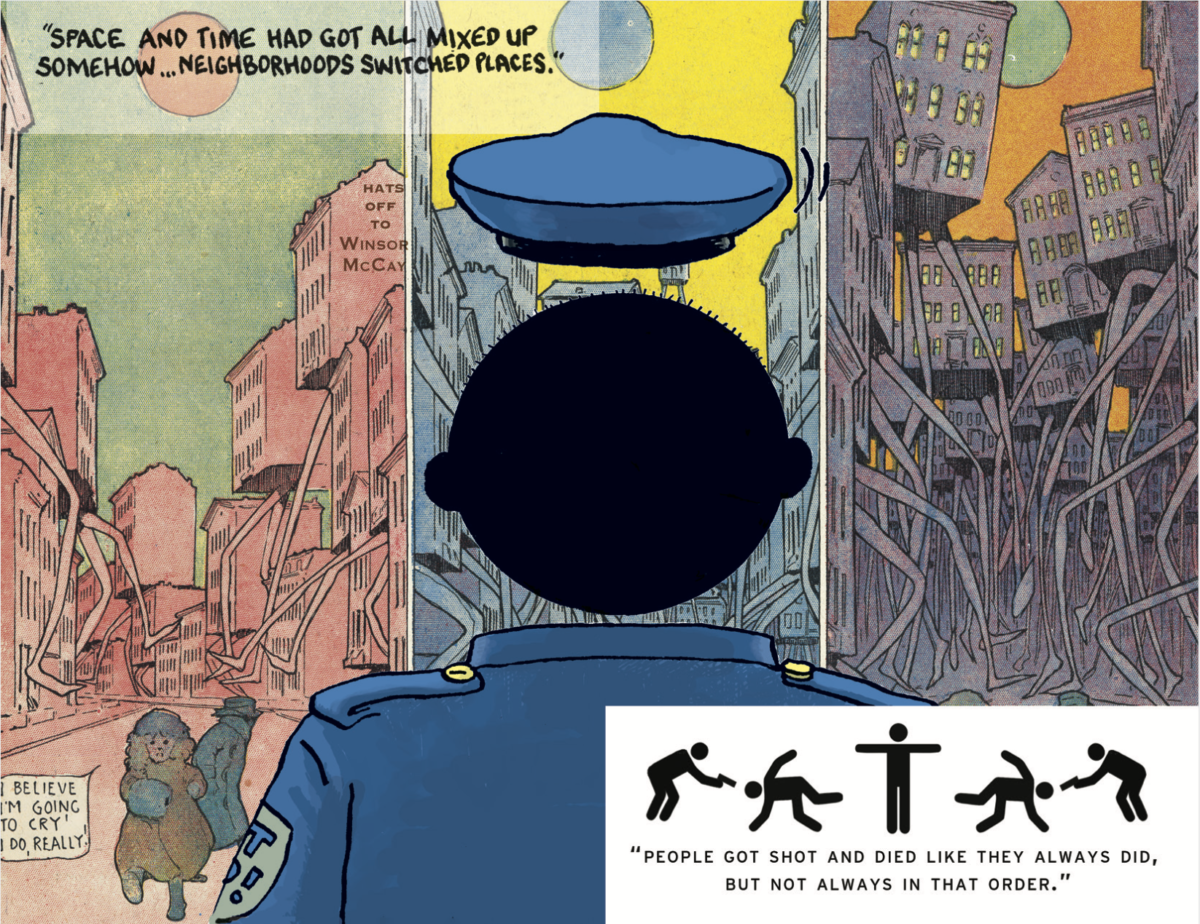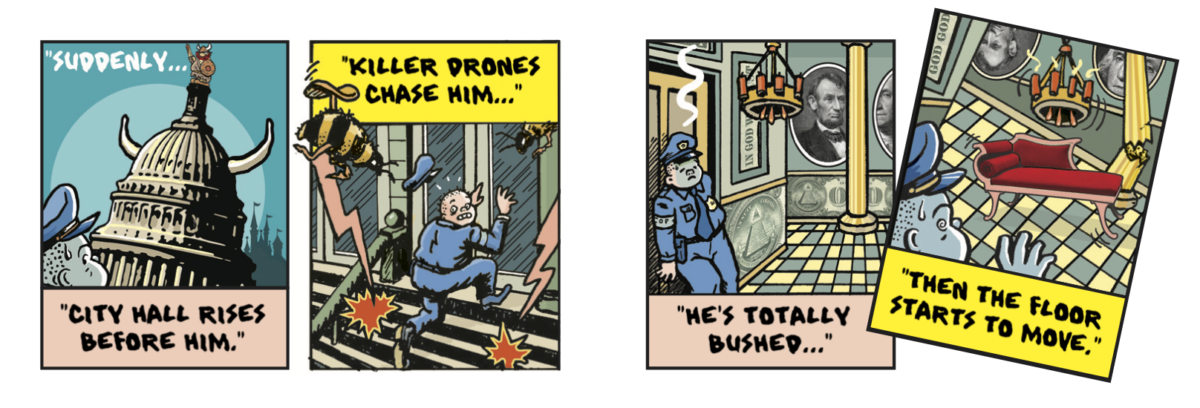
“Our Zeitgeist has left us mostly with shards of media as our reality. As a writer, or an artist, one tries to gage the atmospheric pressures that surround us.”
Physically pocket-sized but ambitious in scope, Street Cop is Robert Coover and Art Spiegelman’s new detective novelette—an anti-racist cop tale about an off-kilter version of the present moment without a news headline in sight. As with Coover’s Noir, it’s clear the detective genre has been digested and reformulated here, mashed up alongside current anxieties around technologized xenophobia and policing. Hardboiled and delightful it’s an entirely sui generis work, illustrated by Art Spiegelman in his first new publication in ten years.
Street Cop is the fourth work in isolarii, a series of “island books” released every two months by subscription. It is available exclusively at isolarii.com.
ART SPIEGELMAN: So first: why a street cop?
ROBERT COOVER: Well, I wrote Street Cop in 2019. It emerged, like everything I write, from anxieties about the present. I had written about private eyes, but the dumb street cop was something new. I liked the idea of a guy who would be technologically inept. It’s about a bumbler who began his career as a crook and drug dealer, before accidentally becoming a cop who stumbles his way through a techno-city where the landscape changes daily thanks to 3D printing—blurring past, present and future. His job is to convict suspects rather than solve crimes, but all he wants, really, is to return to the old part of town, a seamy noir-like zone where his urges, and their many flaws, are permissible.
AS: When I first read and signed on to illustrate your story early in 2020’s quarantine, I was grateful to dive into a Dystopia Next Door and escape the one that surrounded us even in the bucolic bunker in the woods we’d retreated to from NYC. Choking on an overdose of toxic news, and compulsively “doom-scrolling”—I really love that phrase—I found the Covid-free air of Street Cop breathable because at least it didn’t have the twin viruses of the Covid pandemic and Trump directly confronting me. Still, the very first picture I drew had Covids in it—it was inevitable that they found their way into the prescient present of the story.
RC: It’s been infected now.
AS: But the beauty of Street Cop, is it’s not about any one specific condition of the present—the whole story is permeated with ‘now’: the dehumanization, people trying to find some connection with somebody else in a world where that seems so impossible, the mysteries of technology interfering with everything and not being manageable at all, and the cop and the crook being one in the same—who knew that our bumbling street cop, or at least his cohort of robocops, would be rampaging across the front pages of the world’s newspapers within weeks of when I engaged with your text?
RC: Yes, and the complexity you’re describing arose precisely because it wasn’t written as a direct response to anything. The street cop himself is right out of an ancient popular tradition, rather than drawn from the news headlines. It was the street cop’s insignificance that I wanted to capture, using the techno-city like a mirror to reflect back his ineptitude. Something of his humanity surfaces, I think, through all the contrary imagery. I often contrast more or less innocent characters and their hostile settings, but in this case innocence and hostility are muddled.
AS: I’ll say! Syntactically and stylistically Street Cop is equally complex. It has a couple of those really nice Hammett/Chandler beats to it, but that’s not as present when you’re describing the business transaction in the pet shop of the living dead, when the shopkeeper is trying to get this guy to buy a zombie. It has a different pattern, a gothic tone, and a different way of telling.
For me, part of the charm was finding the things that connect the mashups in Street Cop—it invites a kind of really weird stirring of how these genres can be reformulated. Which leads me to the fact that, with us two working together, people might say it’s two “postmodernists” coming into collision. I’m not exactly sure what postmodernism is, but we are both quoting from a popular culture data bank, and cross-referencing each other.

RC: Certainly, but I’ve always resisted being labeled anything, particularly “postmodernist.” It always felt a lot more abstract than what we were doing. I once ran a conference in which I asked all the critics present to define postmodernism: it ended up in laughter.
I’ve constantly and actively looked for a means to distance myself from my traditional realist predecessors, and I think I found ways to do that. Which is how I became what the critics call a postmodernist. I see what you’re describing as my own brand of realism.
AS: It’s a little bit like what happened with the painters who had to paint after cameras were invented and they had to find a new realism that fragmented a landscape and turned it into something that weaves between depth and flatness, which they started calling Cubism. It was a natural response to the particular type of realism that a photograph produces, but it was still an attempt to reflect reality, in the same way that your writing now might be closer to reality than a news item can be.
Our Zeitgeist has left us mostly with shards of media as our reality. As a writer, or an artist, one tries to gage the atmospheric pressures that surround us.
RC: That’s right. When people ask me, I say that I learned my realism from Kafka. Street Cop is a good example of my kind of realistic tale.
AS: I discovered Kafka when I was about twelve years old, and I shouldn’t have been in that section of the library! “The Metamorphosis” struck me as an exceptionally good episode of The Twilight Zone—which every week described itself as “a dimension as vast as space and as timeless as infinity”—but was, of course, about the present it was written in.
There are so many aspects of Street Cop that have to do with time cracking—and space as well. They’re a good double act, Time and Space. And I gotta say that time and space losing their coordinates was part of the real inspiration for the illustrations I made. The spreads are inserted so they refer backward to the preceding page or so one has just read, and contain visual and verbal information that is unpacked in the pages after. They try to smash together the past, present, and future in a way that echoes the text’s narrative. I think that’s at the heart of how the story reflects the strangeness of our current reality and its veil of nostalgia.
RC: Yes, there are strange things that happen in my fiction. But strange things happen in the real world, too.
AS: Pete Hamill wrote this book called Downtown, where he talks about NYC and the differences between an uptown and downtown sensibility—how some uptown institutions and buildings belong downtown and vice versa (shades of Street Cop’s techno-city). He talks about nostalgia— for the automat, old Penn Station and whatever—saying it’s not enough to simply look back fondly. It’s also your obligation to not forget it. And what you have to accept is that the central fact of the city is its change. Stores that were there six months ago are gone, even before the new COVID-reality caused things to change faster than ever…
RC: Closing down stores one after another—
AS: Yeah, it requires embracing the past, while also learning to accept what’s come to replace it. You have to embrace change, because you just entered the narrative at a certain point, when they had automats, and pulp magazines, or whatever. You have to be able to hold that in mind and still see what somebody else will have nostalgia for fifteen years later—that’s part of Street Cop’s distinct mix of past, present, and future.
The story is obviously about the present too—that’s its job. But I’m interested in the fact that there is a kind of real looking back that’s part of Street Cop. It’s not just taking on the police procedural without a manual. I kept coming back to its particular kind of nostalgia: nostalgia for the gutter.
And I guess it led me into the visual world borrowed from the “old part of town.” “Okay, this is gonna be populated by the early comic art of the last century.” So that my idea of futuristic stuff is stuff from the 60s and before. You know, Buck Rogers—
RC: That’s how my mind worked too. I was aware of the kind of ruptured past that is there, and that we live with it as a kind of shadow existence behind us. I love your phrase “nostalgia for the gutter,” by the way. Street Cop is much-infected by such nostalgia.
AS: The word nostalgia was never meant to be a marketing term for repackaging old TV shows. It’s a much more poignant emotion. In Russian, it carries qualities of a disease or pain. The pain of conjuring up that past.
That painful remembering is what makes our Street Cop so human. Particularly in light of the futuristic world of the story, which is so without character, without texture—all you are left with is the soulless smile of an Electra—your rewriting of a Siri or an Alexa—on your phone.
RC: Yes—and there are two Electras in the story: the mangled corpse of a once living person and the cold AI on the phone. The once-alive, zombie Electra naturally developed in that way for me when writing. She developed as a character, and then became a kind of heroine.
AS: I’ll say! She’s the heartthrob.
RC: You can see her heart throb through her body!
AS: An article by Todd Gitlin on postmodernism in the New York Times back in the late 1980s pointed to Maus as a postmodernism that wasn’t just “numb, recombinant fiction” but offers “the real news of subsurface feeling, sense and sensibility.” Maybe it’s why I was so satisfied by the ending of your story with Electra’s words “I love you,” even if they were twisted through a pile of meat. That there actually is something very human that’s throbbing and trying to get out—it’s a mixing of genres, but not for its own sake only.
RC: Something very human. The struggle for love, for a happy ending, the struggle against fate. Because these characters—the Electras and our bumbler—are caught in narratives that they have inherited, that they have not chosen, and from which they are desperately trying to escape, often only to fall into another.
AS: Much like ourselves in our own lives.
RC: Yes, we’re trapped by the tales of the dead. Most people simply accept the stories to which they are confined—as that’s the easiest way to live—but others do find ways to resist and my ambition is that some of my characters can act like models for us, for resisting our entrapment.

AS: That leads me to ask, as we go through our interpretations of this shared thing—how on earth did you come to ask me to do this? This is one of the only books you’ve ever had illustrated before. When I first got your manuscript and read it, I had my fingers crossed that it wasn’t about mice or Jews so I could say yes to taking it on! It’s what most people know of my work and expect; but part of the issue for me was, how do I illustrate something like this?
RC: I’ve got to admit, I didn’t expect it to be as good as it was—I thought it was simply an impossible task. But I think that your drawings are a proper answer to that question. I’ve always loved Maus, but this is something else entirely. If you’d have done things that were closer to my book, it might not have worked as well. Your drawings revealed things I didn’t know were there. It’s been a revelation.
AS: Didn’t you want to work in comics at one point early in your career?
RC: I did. I drew comic strips for my family, when I was eight or nine years old: writing up the family story, and illustrating it, and so on. But it was a desire that died fairly young. I mean, it was not something that I felt committed to. Writing was the central thing.
AS: Do you still doodle?
RC: I do, I still draw faces. And I tend to doodle in the margins of whatever I’m working on. They’re not very good, though an art teacher once saw my doodles and asked me why I didn’t do those instead of the imitation art I was doing. I was trying to use watercolors in a proper way at the time.
AS: I wanted to be a cartoonist because I couldn’t draw and I liked the way all these other people who couldn’t draw, drew. That made me fall deeply in love with it. I was just copying everything and trying to figure out, “now how does this guy make an ear? He just puts a backward six inside a ‘C’. And the other one does a backward ‘e’. And this guy does some other more convoluted version.” So there was really almost a written language of pictures that I had to learn and try to put together.
RC: That’s how I think about tropes, whole pieces of genre even, which get worked and reworked as they travel—their morals warping as they’re retold from place to place. They are universal and immortal—and, as you say, may be drawn differently, or made new again through juxtaposition or recombination—and that is the mess called human nature.
AS: We work with these crude linguistic building blocks that need to be retooled to say anything—whether we use words or pictures. And right now, politically speaking, much of what is on the side of the angels in these battles is humorless and censorious—and so not open to allowing thoughts to come and get expressed and then reformulated into other, better thoughts. We need humor because humor is the code that lets you break through conventional thought—its nature is to try to find a side entrance.
RC: I agree with that too, part of the problem now is that our sense of humor is missing. But it’s there still in a few people and maybe one of them will rise to the occasion and make it happen.
AS: You did that with The Public Burning too, which was the first time an author used a living public figure as a character in a novel—Richard Nixon.
RC: Well it’s with humor, and mockery, that I’ve often taken aim at our patriotic and cultural myths. That’s the role of the storyteller—to recombine and reinvent them, and tease their untruths—their delusions of freedom, justice, and equality or baser impulses of racism, sexism, and fear.
And you need to be open to that—otherwise you progress, but only through repression, which is never healthy.
AS: As someone I know wrote in an email to me, “If there’s a God, he’s probably up there binge watching Planet Earth 24/7. Because, what a story!” The only thing to give one pause is the idea that it’s happening to real people and it’s on our planet Earth. The idea that there could be such a thing as a democracy is just a failed experiment. It’s amazing that even some form of it, or an illusion of it, has lasted as long as it has.
RC: Agreed. The advocates for democracy—and the earth—seem either destined to be destroyed, or they will manage to somehow recreate it illusorily.
AS: The pandemic now has acted like a kind of fingerprint powder helping to make all the crimes visible—the racism and xenophobia, the cruelty of how our economic and natural resources are distributed and used. So that there’s no denying how incredibly racist America always was and continues to be—and the fact that this is our history, anything else was just fantasy stories.
RC: The malignancy of the world is nothing new, and we’ll always be waiting, watching, and hoping for a clean, happy ending. But there are none to be had—and I think that’s dawning on people more and more.
AS: But it’s hard to get a handle on what we’re living through now, it’s so big. And our book is so small.




